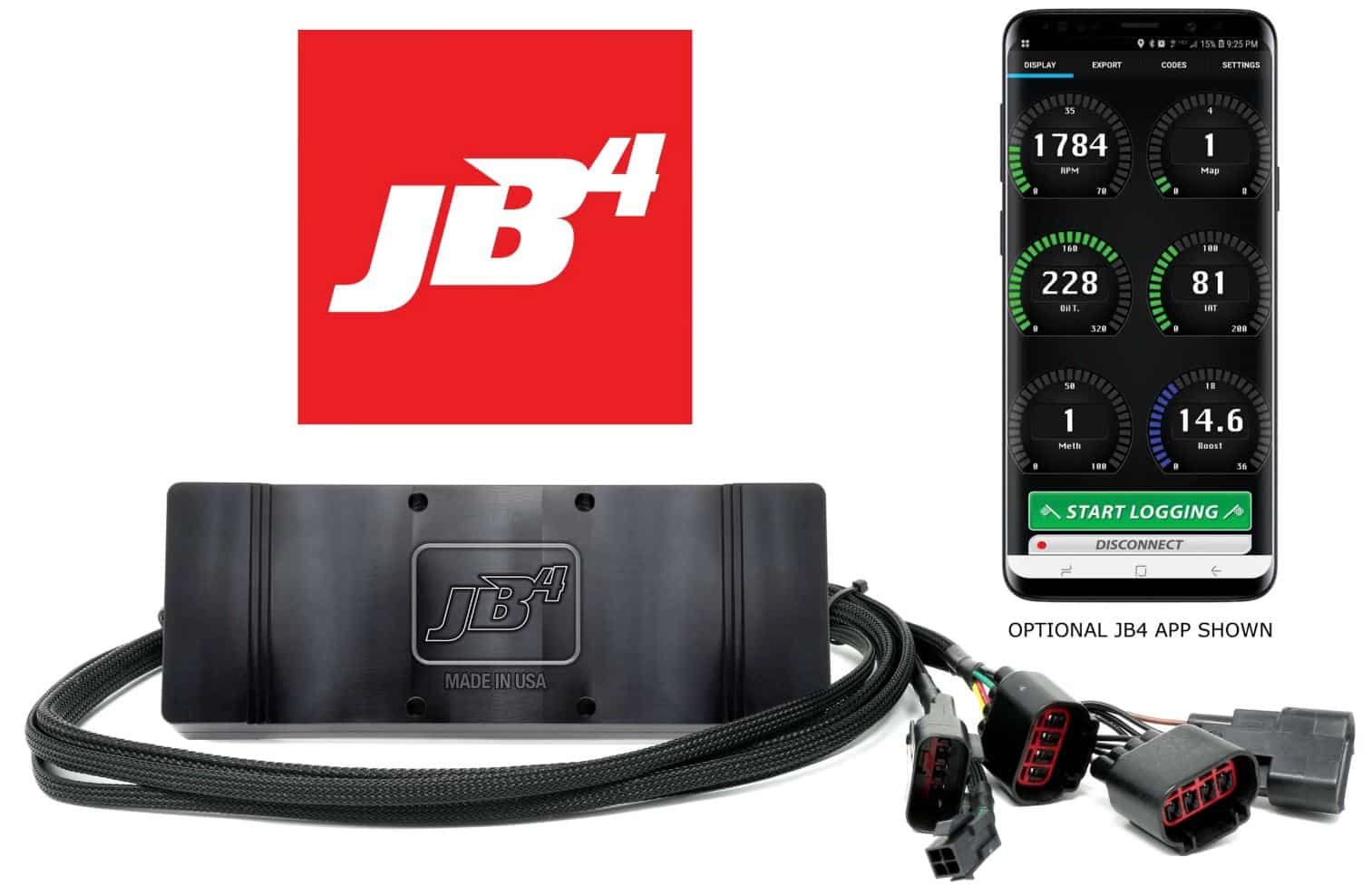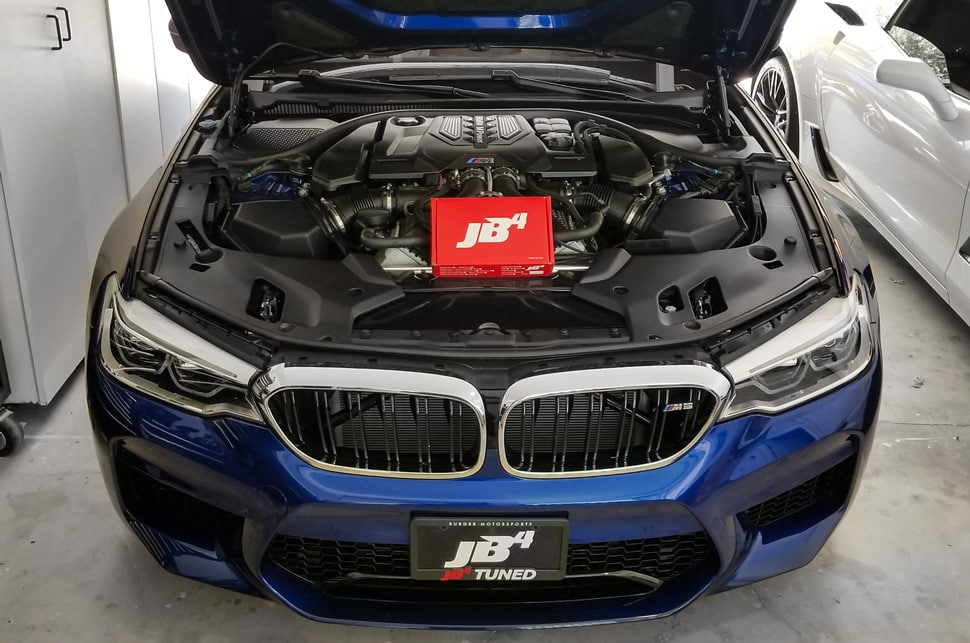Burger Motorsports JB4 Frequently Asked Questions
What’s the difference between a JB4 and a flash tune?
This question comes up often when customers are evaluating what method to use for modifying their vehicle’s performance.
JB4 vs cobb bm3 bootmod3 mhd apr giac dmetune weistec flash hptuners eurocharged unitronic ktuner hondata openflash and countless others.
The JB4 is a programmable computer that attaches between the ECU and vehicle sensors allowing it to adjust your vehicle’s tuning by tapping into areas of the factory flash mapping that are not normally available. Unlike other similar-looking tuning systems the JB4 is also able to tap in to CANbus – analogous to a spinal cord – allowing it to communicate and receive information from not only the ECU but also the transmission computer, stability control module, dash module, and many others. This CANbus connection provides a complete set of real-time operational data which is then dynamically incorporated into your JB4 tuning.
A flash tune, on the other hand, modifies the tables on the ECU directly for higher performance. Usually loaded via the vehicles gateway on the OBDII port, but in some applications directly to the ECU by drilling a hole or disassembling the ECU to access the processor inside.

So which is better? A better question is probably which is better for your specific needs?
Installation: Flash tuning can be simpler initially as there is no extra hardware to install. With the JB4 you plug it into sensors in the engine bay, usually taking 20 to 30 minutes the first time as you learn where each sensor is for your specific model. Once you’ve installed it once, most JB4 systems can be fully removed in less than 10 minutes. Flash tuning, while easy to install, can never be fully removed. Even if flashing to stock later, permanent traces of the more aggressive tuning will be stored in your ECU, transmission computer, stability control module, and, if flashed via the OBDII port, also your gateway module.
Performance: The JB4 is able to achieve a dramatic performance increase, completely transforming your vehicle. But it’s also more limited relative to a flash tune as it is working off the factory flash tables. While performance is usually very similar between the two there are a few things the JB4 just can’t do including changing fuel injection timing (exhaust pops and bangs), raising the RPM limiter, adjusting valve timing, and in some cases, raising the speed limiter.
Cost: There is a wide range of price variance for flash maps ranging from a few hundred dollars up to several thousand depending on the application. For more advanced higher-power maps, “custom tuning” is usually required which can double the flash cost. The JB4, on the other hand, ranges from $479-$900 and includes 8 unique maps, including maps for pump gas, race gas, ethanol fuels (E85), factory tuning, VALET mode, WMI integration, and a user-defined map. Because of the dynamic nature of JB4 tuning, it is able to self-tune critical and difficult-to-dial-in aspects of tuning such as wastegate control and fuel trim range for various modifications, climates, and vehicle conditions, largely eliminating the need for expensive and time-consuming custom flash tuning. Unlike most flashes and custom-tuned flash maps which are disposable, the JB4 can be removed and reinstalled on your next vehicle or resold down the road.
Safety: While the flash tune can adjust more tables directly there is also a lot more that can go wrong. Many flash tunes adjust the knock sensor feedback and other critical tables, sometimes unwittingly, creating a much higher risk of engine damage. The quality of the flash tune depends entirely on the skill of the person who wrote it and in many cases flash maps are purchased from a single murky source and resold by several tuners without high levels of R&D performed. Flash tuning is also limited to the factory logic paths which, while generally sufficient for factory vehicles, can become inadequate when dealing with higher-powered and modified vehicles. The JB4, on the other hand, cannot interfere with the factory safety systems by design. It can only run your tuning from the extensively tested factory programmed tuning tables while also adding a robust range of additional safety systems not possible flash-only. Including going into bypass mode if boost exceeds a user defined value, AFR in either bank goes lean, fuel trims in either bank max out or vary dramatically from each other, fuel pressure drops below a specific value, etc. The JB4 continually monitors your tuning in real time via CANbus and turns off if things go sideways. It’s a lot like having a professional tuner sitting in your passenger seat watching over your engine data in real time every time you floor it.
Map changes: Flash tuning usually requires you to reflash the vehicle any time you want to make a mapping change, for example when changing between different fuels or going back to factory tuning. With a JB4 you can change performance profiles or revert back to factory tuning in real time using your smart phone, and in some cases in the dash directly. In many applications the JB4 can even “auto tune” your vehicle adjusting its tuning parameters on the fly based on CANbus information to maximize performance and safety for the current weather, fuel, and modifications being used, providing a true set-it-and-forget-it solution.
Features: The JB4 includes many features not possible flash-only including smart phone integration via JB4 Mobile for iOS or Android devices allowing full data logging, diagnostic code read/delete, and various levels of user adjustment. Among the most popular user adjustment features is “boost by gear” which allows the JB4 to limit boost/torque in lower gears for improved traction. The amount of boost limit can be adjusted on the fly in the app to optimize performance for track conditions. Other unique features include E85 sensor integration, allowing the JB4 to read in ethanol mixtures and adjust tuning automatically to maximize performance, WMI (water/meth) integration and progressive safety, and in most BMW models, exhaust flap control from the turn signal, in dash boost and knock gauges, and much more. While JB4 features vary by platform, each platform receives free regular firmware updates where we add additional features, improve mapping performance, and continually refine the tuning to ensure JB4 customers remain ahead of the pack.
Can I run both? One unique feature of the JB4 compared to other tuning systems is that it’s fully compatible not only with the factory flash map but with off the shelf flash maps, custom tuned flash maps, or any flash map you want to run. In fact we regularly publish free JB4 back end flash maps meant to be used in conjunction with the JB4 for those customers who are comfortable with flashing their car and looking to add features not possible JB4-only. The addition of flash mapping to the tuning flexibility, features, and safety the JB4 provides gives you the best of both worlds and is commonly found in record setting vehicles.

What’s the difference between JB4 and RaceChip?
JB4 vs racechip dte nm vr afe scorcher lap uncle and countless others.
While the JB4 is the best and most highly developed piggyback tuning system there is no shortage of would-be competitors. We’ll discuss just a handful of the differences below.
What is CANbus anyway? CANBus is the spinal cord that connects the many modules or computers throughout your vehicle together and allows them to operate as a cohesive team. When a technician plugs a tool in to the OBDII port for diagnostics, it’s tapping in to the CANbus allowing full access to the entire vehicle. The JB4 includes this same level of vehicle-wide computer integration. A JB4 with its CANbus connection can read virtually every sensor on your vehicle including critical internal calculations like fuel trims and knock count. This allows the JB4 to take gas pedal position, throttle position, oil temperature, water temperature, intake temperature, engine speed, air/fuel ratio, fuel trims, ignition advance, knock, and countless other factors in to your tuning, providing smoother, stronger, and safer performance. On the other hand boxes like RaceChip without CANbus are limited to reading only the boost sensors they attach to resulting in a “MAP clamp” tuning approach. Common symptoms of non-CANbus related tunes include stuttering, poor shifting, and reduced top-end performance. Since these systems can’t correct the conditions causing the issue, their only solution to any tuning issue is to “turn down the boost”.
It’s not just about boost. While boost control is the most visible aspect of piggyback tuning it’s important to keep in mind fuel & ignition control are just as critical to engine performance and safety. Cranking up boost without properly accounting for fueling and ignition can result in detonation, knocking, stuttering, excessive EGT melting parts, and degraded performance. While JB4 strategies for fuel and ignition control vary by platform – using its additional signal ports, processing power, and CANbus – boost, timing, and fuel are always accounted for. And unlike other tuning systems, you don’t need to take our word for it. The JB4 allows monitoring of all critical engine criteria including diagnostic faults in real time via the optional JB4 mobile app.
What’s with all the different JB4 systems? Each JB4 is designed from the ground up specifically for your vehicle. That includes BMS sourcing one of every vehicle we of support for development and long term R&D. It’s why you’ll usually see *actual* dyno charts and performance metrics for each vehicle on our website and why the JB4 systems themselves need to vary by platform. With each application we optimize the JB4 hardware and software for that specific platform and we always commit to future development through free JB4 software updates that can be loaded via the optional JB4 mobile app. Updates that give the JB4 improved performance, new features, more mapping options, and much more. It’s why you’ll often see BMS employees active within Facebook groups and car forums interacting with our customers for feedback and ideas for improving the JB4 for that specific application.
Our competitors, on the other hand, usually take a universal approach to tuning. Using the same hardware and software they apply the minimum required changes to make it compatible across as many different turbocharged vehicles as possible, often ignoring critical platform differences and changing only the MAP sensor connections on the harness before moving on to the next vehicle application never to return.
What’s the deal with the gas mileage claims? JB4 competitors often make false claims of “improved fuel economy” using their tuning systems. It is not possible to improve fuel economy using MAP sensor tuning and generally speaking more horsepower requires more fuel to support it. So what is the basis of these claims? It all comes down to how fuel economy is measured by the factory computer in some vehicles. Since RaceChip and other simplistic MAP clamp tuning systems apply a preset boost increase at all times regardless of gas pedal position or operational mode, some vehicles base their internal mileage reading off this full time bogus signal resulting in higher than actual mileage displayed in dash. If you measure economy using your trip meter in dash you’ll discover not that fuel economy has increased but rather that RaceChip has simply made the internal gas mileage reading inaccurate. The JB4 on the other hand generally does not negatively affect the economy readings in dash, and while it’s always true that making more power requires more fuel, with the JB4 you’re only using more fuel when racing around under heavy throttle making more power. Fuel economy during normal driving with the JB4 enabled is unchanged.